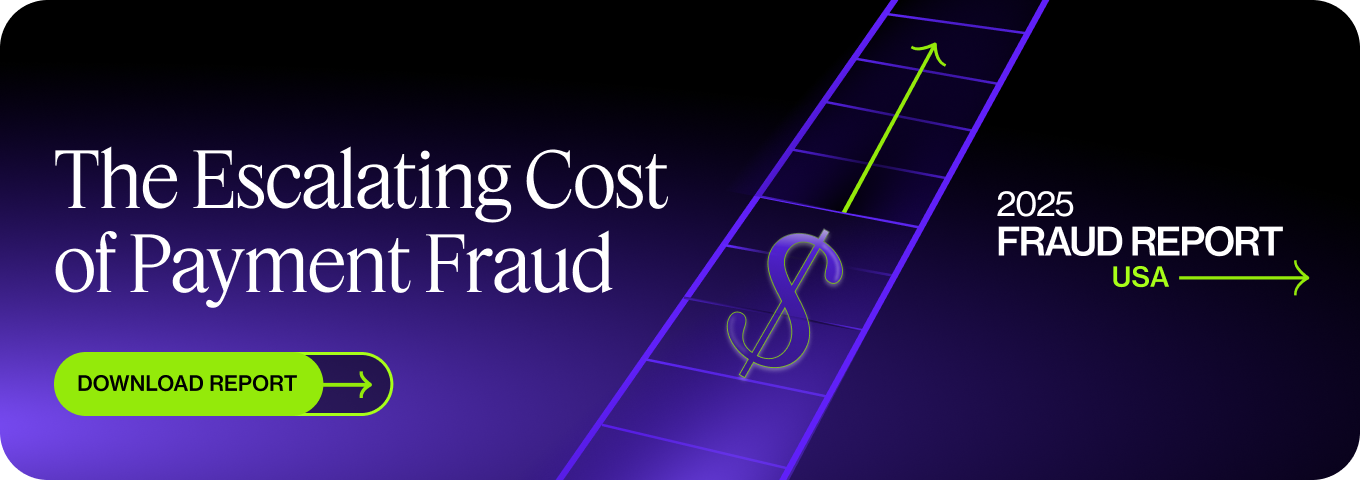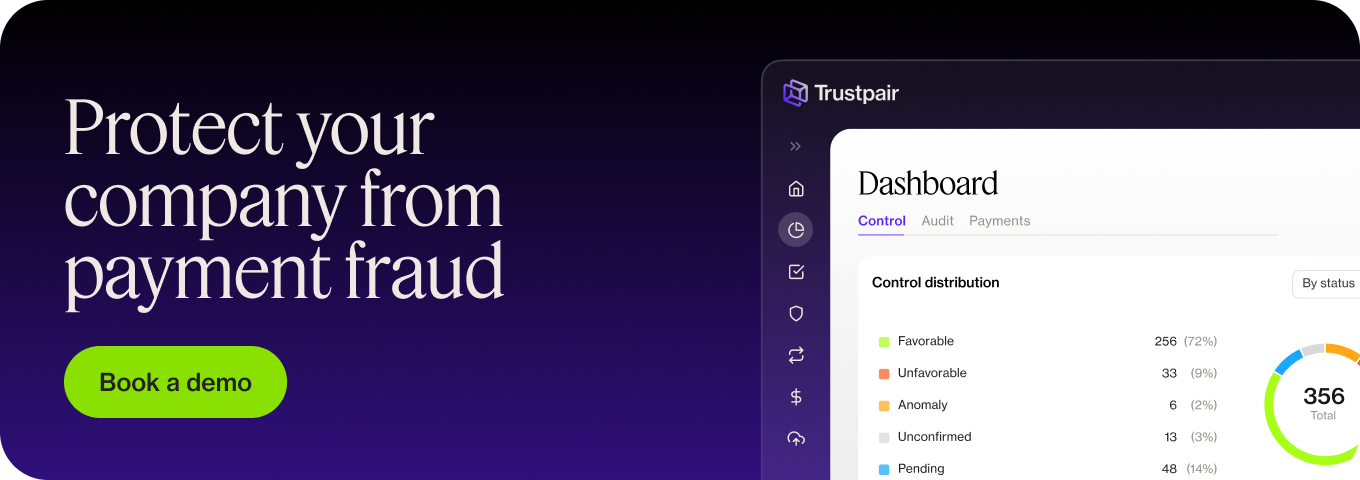Bank account frauds and other financial scams aren’t new. Unfortunately, online fraud attempts have multiplied with the development of the Internet and the digitalization of data – and so have the costs associated with fraud. Compared to the pre-COVID area, fraud costs are said to have increased by 10%.
In corporations, the department in charge of financial security must face this heightened risk which bears a heavy weight on the organization. Alongside the financial risk, fraud attempts can also damage a company’s reputation and its long-term relationships with its existing – and future – customers. In fact, studies have shown that the reputational cost of fraud has been calculated to be up over 140% of the fraud event itself.
Discover 6 types of banking fraud to watch out for in your financial department so that you can get better organized and protect yourself more effectively.
Do you want to learn more about payment fraud? Check out our free study!
Accounting fraud
The Association of Certified Fraud Examiners (ACFE) estimates that on average, companies lose 5% of their revenues to fraud each year.
Amongst the different ways to commit fraud, we find accounting fraud, which can show up in several ways.
This type of bank fraud mainly impacts the loans given to the company. The company falsifies its accounts to make believe that it’s highly profitable when it actually is unsolvable. A bank may accept the loan on the basis of these false accounts but never gets its money back.
The infamous Enron affair, which caused a scandal in 2001, is one such example. The company artificially inflated its profitability while hiding its losses through shell companies and falsifying its accounts. Another example is the Wirecard affair which came to light in 2019. Otherwise known as “the German Enron”, it amounted to almost 2 billion euros.
Money laundering, one of the hardest bank fraud to spot
Money laundering has been on the rise these past few years. In fact, according to the United Nations, money laundering causes 800 billion dollars of losses every year.
Concretely, money laundering is the process of making money obtained illegally look legit. The illegally obtained money is reinvested in very legal activities to launder it. This type of fraudulent operation can hide big scale criminal activities, like terrorism or drug trafficking. There are different types of money laundering, like tax evasion or fraud through false invoices.
Money laundering can be very difficult to spot. To prevent this from happening in your company, respect your local laws and build a strong due diligence process before entering a new business relationship with a partner.
Even better, you can use a solution that checks third party financial information automatically, like Trustpair. Our solution offers a unique method for fraud detection which allows 200 companies worldwide to protect themselves against fraud attempts. Contact one of our experts to learn more!
Fraud through dishonest traders
Are you in investment banking or another organization that deals with financial traders? If so, it’s important to be careful with your work environment to protect yourself against unscrupulous traders.
They could commit fraud by doing non-authorized transactions. Unscrupulous traders inflate the results of their trading activities so it looks like they generate a lot of money, when in reality they create little to no profit.
The recent FTX scandal is an example of fraud through dishonest traders. Bankman-Fried (known as “SBF”) created in 2019 FTX as a platform for trading crypo-currency. In 2022, SBF and other company executives were accused of using their client’s cash for personal and political use. He is now facing fraud and money laundering charges, allegedly owning FTX customers about $8 billion.
Business or individual loan fraud
Fraud through loans can take many forms. It can be done through accounting as we’ve mentioned before, where a company presents false accounts to get a bank loan. It could also be done by an individual using the same method.
Loan fraud can also be when a too-good-to-be-true loan proposal is sent by email to a potential victim, who cannot resist such a good interest rate and the absence of any collateral. The fraud victim is however asked to pay for administrative fees as soon as possible. That’s when they pay that they realize there never really was any legitimacy in the loan offered.
Loan frauds are usually a phishing scam: scammers send an email pretending to be someone they’re not to get their hands on some money illegally.
Fraud through factoring
Fraud through factoring happens this way: the fraudster opens a business account in a bank. They then convince the financial establishment to cover its invoices in advance (also called factoring) with its clients who are accomplices.
After some time, the bank is lured into a false sense of security by the so-called clients who pay their invoices on time. At this point, the client asks the bank to pay for its invoices in advance. Once done, the scammer gets the money and disappears forever. The bank never gets its money back.
Phishing and spear phishing fraud
Phishing or spear phishing are widely spread frauds that impact companies as well as individuals. In the case of companies, it happens through email attacks whose goal is to push the user to do a certain action. The victim will for instance click on a link that’ll lead them to a fake payment website, or download an attachment with a virus (malware or even spyware).
The difference between phishing and spear phishing lies in targeting. Phishing emails target a wider audience to increase the potential number of victims, whereas spear phishing only targets one recipient through a very specifically tailored email.
A typical example of spear phishing is what you call the the CEO fraud: a fraudster pretends to be the CEO of a company who requires an urgent transfer towards a specific bank account. Because the email looks legit (the email address has been hacked or is really similar to the CEO’s real one), the funds are transferred. It’s only later that the targeted employee will realize they didn’t deal with their CEO, but with a scammer
Several solutions exist to protect yourself from phishing:
- Never click on a link without knowing who the sender is,
- Be careful of any suspicious emails or requests of personal information
- Choose digital identification solutions for third parties.
Bank transfer fraud
“Bank transfer fraud” is an umbrella term that covers a wide variety of frauds.
Scammers can for instance try stealing confidential information (like a user’s name, password, credit card information, or even social security number) on their online bank and transfer money directly to themself. Often, the victim faces a fake provider who convinces them to transfer some money through fake invoices or fake bank-account details.
There is also “CEO fraud” which is when the scammer pretends to be the CEO and contacts targeted people within the company (accountants for instance) to ask them to make a transfer to a new bank account
However, there are various ways to protect yourself against bank account fraud. They require training and making your coworkers aware of the different fraud methods that exist, like phishing or CEO fraud.
Preventing bank-account fraud also implies controlling the bank-account details of your third party (providers and clients for instance). If you don’t manage these data well, you’re at risk of paying the wrong people and of being a victim of fraud. The solution? Using a third-party control digital solution for fraud-prevention any fraud attempt from happening. Learn more about third-party management in this article.
Are you looking for a solution to prevent bank transfer fraud? Trustpair supports financial departments of large companies in the automated control of third-party bank accounts and the safeguarding of the entire payment chain. Want to learn more? Contact one of our experts.
Key Takeaways:
- ACFEs estimates companies lose 5% of their revenue to fraud each year.
- Account fraud and money laundering are two types of fraud that are closely linked and happen internally.
- Phishing and spear phishing are widespread frauds that are carried out through email and ask the user to make a specific action
- Bank transfer fraud is commonly used by hackers: through identity-theft, they usurp someone else’s identity and give their own bank account details to get their hands on the money.
- Fraud attempts are getting more diversified and numerous nowadays. Unfortunately, protection against those is still too low. Trustpair is the way to elude bank transfer fraud attempts.






